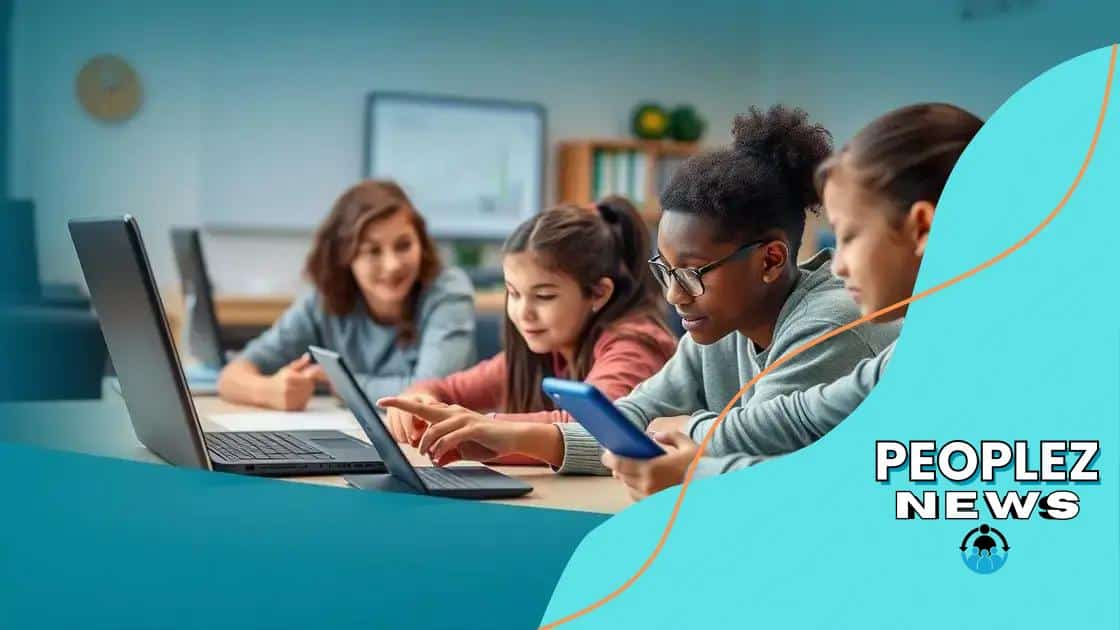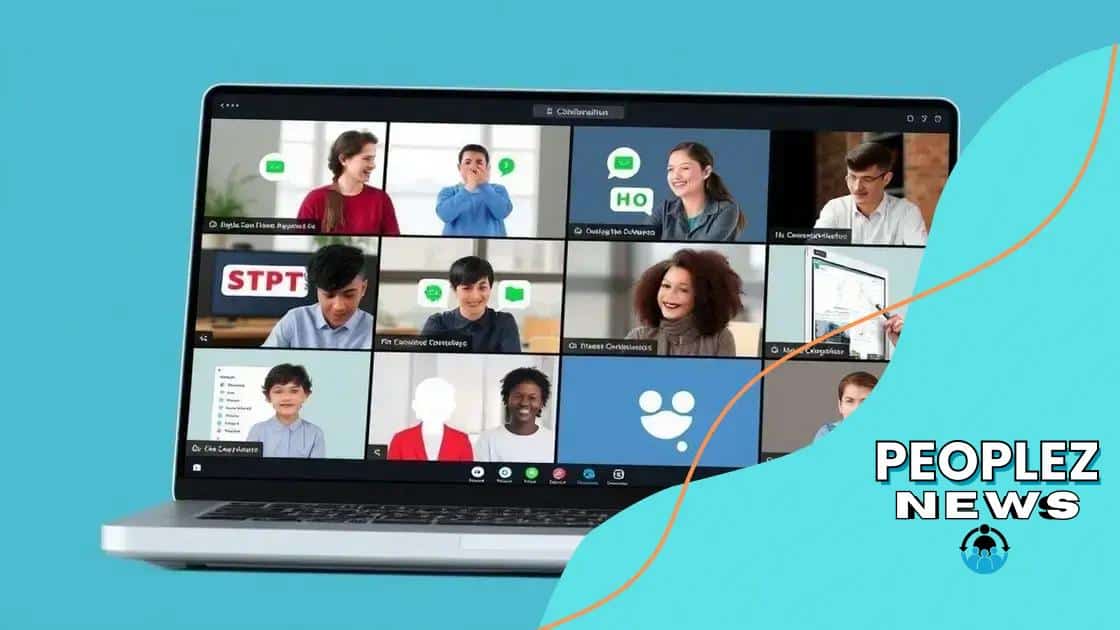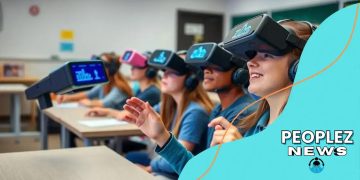The impact of virtual classrooms on student collaboration

The impact of virtual classrooms on student collaboration enhances communication, supports diverse learning styles, and prepares students for a globalized future through innovative technology and flexible learning environments.
The impact of virtual classrooms on student collaboration is reshaping how learners interact and work together. Have you ever wondered how flexible online environments can enhance teamwork among students? This article dives into the dynamics of collaboration within virtual learning.
Understanding virtual classrooms
Understanding virtual classrooms is essential in today’s educational landscape. Virtual classrooms allow students to connect from anywhere around the world. They are not just a response to necessity, but a way to enhance learning experiences.
What are Virtual Classrooms?
Virtual classrooms are online platforms where students can learn in real-time with teachers and peers. These classrooms often use video conferencing tools and interactive software. Within these spaces, learning can happen whether the participants are homebound or miles apart.
Key Features of Virtual Classrooms
- Real-time interaction between students and teachers.
- Access to a wide range of resources and materials.
- Flexible scheduling options to accommodate different time zones.
Moreover, virtual classrooms create an engaging environment. Students can participate in discussions, collaborate on projects, and even share ideas in group settings. By using technology, students gain skills that are vital in the modern job market.
Another important aspect is the adaptability that these classrooms offer. For example, students who may struggle in traditional settings can thrive in the virtual format. They can learn at their own pace and revisit materials as needed. This aspect enhances individual learning opportunities.
Benefits of Understanding Virtual Classrooms
By understanding virtual classrooms, educators can enhance their teaching strategies. This ensures students are receiving the best possible education. Some benefits include:
- Broader access to education for diverse student populations.
- Increased opportunities for self-directed learning.
- Enhanced digital literacy among students.
Furthermore, knowing how to navigate a virtual classroom is a critical 21st-century skill. As we advance technologically, embracing these changes prepares students for the future.
In conclusion, understanding virtual classrooms means recognizing the potential they have to transform education. It opens doors to new ways of learning and teaching, fostering a collaborative spirit that benefits all students.
Benefits of collaboration in virtual settings
Benefits of collaboration in virtual settings play a significant role in student success. As education shifts online, understanding these advantages becomes crucial for students and educators alike. Collaboration in virtual classrooms allows for a more dynamic and engaging learning experience.
Enhanced Communication Skills
By participating in group projects and discussions, students learn to express their thoughts clearly. This enhances their communication skills, which are vital in today’s world. Through chat functions and video calls, students practice articulating their ideas and responding to feedback.
Increased Engagement and Motivation
When students work together, they tend to feel more engaged. Collaboration fosters a sense of community where everyone feels involved. This environment keeps motivation levels high as students share their successes and challenges. They support one another in achieving common goals, making learning more enjoyable.
- Collaboration brings diverse perspectives to discussions.
- Students gain insights from peers that they might not consider alone.
- Working together can spark creativity as ideas merge.
Moreover, collaborative learning leads to better retention of information. When students explain concepts to each other, they solidify their understanding. This peer-to-peer teaching is a powerful tool for mastering complex subjects.
As students collaborate, they also develop important interpersonal skills. These include teamwork, problem-solving, and conflict resolution. Such skills are essential not only in school but also in future workplaces. In virtual settings, students learn to navigate digital tools that enhance collaboration.
Access to Broader Resources
Collaboration in virtual settings provides access to a variety of resources. Students can collaborate with classmates from different parts of the world. This experience enriches their understanding of diverse cultures and viewpoints. Additionally, they can utilize online databases and tools collectively, enhancing their learning opportunities.
In essence, the benefits of collaboration in virtual settings create a holistic learning environment. Students grow academically and socially, preparing them for the collaborative nature of today’s workforce.
Tools facilitating collaboration

Tools facilitating collaboration are vital for enhancing communication and teamwork in virtual classrooms. In today’s education, choosing the right tools can make a significant difference in how effectively students collaborate.
Popular Collaboration Tools
There are several popular tools designed to promote collaboration among students. Each tool has unique features that cater to different needs and preferences. Here are some widely used platforms:
- Google Classroom: This platform allows teachers to create, distribute, and grade assignments in a paperless way. It integrates with various Google tools to streamline communication.
- Microsoft Teams: This tool offers chat, video conferencing, and document sharing all in one place. It’s widely used for group projects and discussions.
- Zoom: Primarily known for video conferencing, Zoom allows students to hold virtual meetings and collaborate in real time.
- Trello: This project management tool helps students organize their tasks and deadlines visually, making group work easier to manage.
Using these tools, students can share files, exchange ideas, and plan their work together. This engagement helps strengthen their understanding of the subjects they are studying.
Benefits of Collaboration Tools
Collaboration tools offer a range of benefits, including:
- Improved communication among team members.
- Easy access to shared resources and notes.
- Enhanced organization of tasks and deadlines.
As students navigate through projects, these tools provide essential support. They keep teams connected, regardless of location, and ensure everyone stays on the same page. Furthermore, using technology in collaboration fosters critical skills that are beneficial for the future workforce.
In addition to enhancing teamwork, these tools promote accountability. Each student’s contributions can be tracked, encouraging responsible participation and ensuring that everyone is involved in the process.
Ultimately, employing effective tools helps create an environment where students can thrive in their virtual collaborations.
Challenges faced in virtual collaboration
Challenges faced in virtual collaboration can hinder the learning experience for many students. While virtual classrooms offer exciting opportunities, they also come with their own set of difficulties that can impact collaboration.
Communication Barriers
One of the primary challenges is the potential for miscommunication. When students communicate through screens, they may not pick up on non-verbal cues, such as facial expressions and tone of voice. This can lead to misunderstandings about assignments or feedback.
Technology Issues
Another significant challenge is technical glitches. Connectivity problems, software issues, or a lack of familiarity with tools can disrupt collaboration. Students may find it frustrating if they cannot access shared materials or attend virtual meetings smoothly.
- Inconsistent internet access can make participation difficult.
- Some students may struggle with learning new technologies.
- Technical difficulties can lead to lost time and reduced productivity.
Moreover, distractions in a home environment can also impact focus. Unlike a traditional classroom, where the learning environment is controlled, students may face interruptions from siblings, pets, or other household activities. This can make it hard to stay engaged during collaborative tasks.
Time Zone Differences
Additionally, time zone differences pose challenges for international collaboration. Students from different locations may struggle to find suitable times for group projects if their schedules do not align. This complicates teamwork and can delay project progress.
Furthermore, the lack of physical presence can create a sense of isolation. Some students may feel disconnected from their peers when working online. This emotional barrier can affect motivation and participation in collaborative efforts.
Addressing these challenges requires intentional efforts from both educators and students. Creating structured communication plans, setting clear expectations, and offering support for using technology can help improve the collaborative experience for everyone involved.
Future of virtual classrooms and collaboration
The future of virtual classrooms and collaboration is exciting, as technology continues to evolve. As we look ahead, several trends will shape the way students learn and interact in virtual environments.
Integration of Advanced Technologies
One major trend is the integration of advanced technologies like artificial intelligence (AI) and virtual reality (VR). These tools will enhance the learning experience by making it more immersive. For instance, VR can transport students to different environments for hands-on learning, while AI can personalize learning paths based on students’ needs.
Increased Focus on Hybrid Learning Models
Another trend is the rise of hybrid learning models. Schools will likely combine in-person and virtual instruction. This flexibility allows students to engage in collaborative work both online and face-to-face. Hybrid models can cater to different learning preferences, making education more accessible.
- Students will have more options for how they participate in classes.
- Flexibility can lead to a better work-life balance for learners.
- Technology will facilitate smoother transitions between learning environments.
Moreover, fostering global collaboration will become more common. With virtual classrooms, students can work with peers from around the world. This interaction promotes cultural understanding and encourages diverse viewpoints, enriching the educational experience.
Emphasis on Social and Emotional Learning
The importance of social and emotional learning (SEL) will also grow in virtual classrooms. Educators will focus on building relationships and community among students. Creating a sense of belonging is crucial for motivation and engagement in collaborative activities.
As we embrace the future, we can expect platforms to become even more user-friendly and interactive. Innovative features will help students collaborate seamlessly, regardless of their location. This evolution creates an opportunity for lifelong learning, equipping students with the skills they need for the future job market.
In summary, the future of virtual classrooms and collaboration looks promising. By harnessing new technologies and focusing on collaboration, education can become more inclusive, engaging, and effective.
FAQ – Frequently Asked Questions about the Impact of Virtual Classrooms on Student Collaboration
What are the main benefits of virtual classrooms for student collaboration?
Virtual classrooms enhance communication, increase engagement, and provide access to diverse resources, fostering a collaborative learning environment.
How do technology tools facilitate collaboration in virtual classrooms?
Technology tools like Google Classroom, Microsoft Teams, and Zoom allow students to communicate, share resources, and work together seamlessly regardless of location.
What challenges do students face in virtual collaborations?
Challenges include communication barriers, technical issues, distractions at home, and coordinating schedules across different time zones.
How is the future of virtual classrooms expected to evolve?
The future will likely see more integration of advanced technologies, hybrid learning models, and a greater emphasis on social-emotional learning to enhance collaboration.





